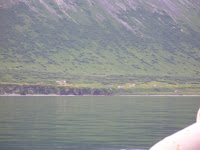

Jones, D.M.(1976).
Aleuts In Transition. Seattle, WA: University of Washington Press.
Picture:Fort Ross Cultural History.(n.d.).Retrieved November 18,2009,from Fort Ross Interpretive Association:http://www.fortrossinterpretive.org/Fort Ross Cultural History.html
August 12, 2001 Souvenir Album.(2001,August 12). Retrieved November 18,2009, from Harriman Expedition retraced: http://www.pbs.org/harriman/explog/081201_photos.html
What is a Baidar? Well, It's an Aleut boat that held 30-40 people. Aleut Baidars were made of cloth and ornaments. These boats were used for war parties and long trips. Now you may ask, What is a Baidarka? It's an Aleut kayak but it holds up to 1-2 people. These boats were used for hunting and fishing. Both of these boats were made of whale ribs and seal or sea-lion skins. The ribs were tied together with hoops and covered with sea-lion or seal skins. These boats were very light. They were so light that they could be carried under the arm. They also had paddles which were made of poles with blades at each end.
The Aleuts had to make these boats strong enough and flexible enough so they wouldn't break in their rough sea conditions.
 One of my Crew members taking pictures
One of my Crew members taking pictures



 False Pass
False Pass Unimak Island
Unimak Island Pavlof
Pavlof Unga Island
Unga Island






